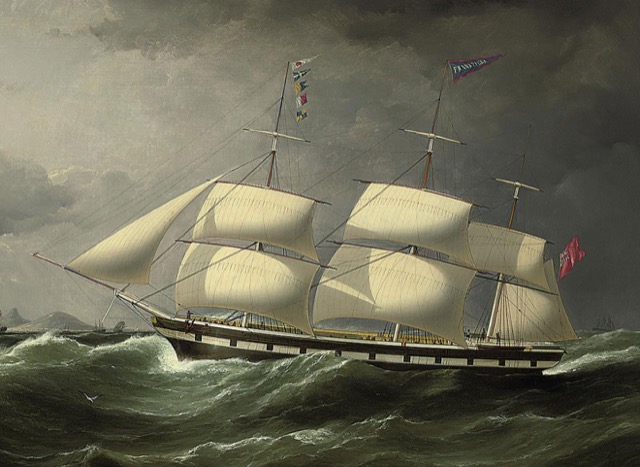
Frankfield 1847
Wooden full-rigged ship, built 1840 New Brunswick, 750 nt.
Owned: Wilson & Co Liverpool
Wrecked: Porth Padrig near Cemaes on North of Anglesey 7 Dec 1847
Approximate position: 53°25.21' N, 4°27.00' W
Captain John Robinson and 28 crew; 21 lost.
Voyage Liverpool to Callao (Peru), via Sydney, returning via Cape Horn.
Frankfield in rough seas: (from painting by Samuel Walters 1847)

From North Wales Chronicle: Dreadful Shipwreck 21 lives lost.
On Tuesday 7th inst [7 Dec 1847] about 10 minutes to 6 in the morning, the ship Frankfield, of Liverpool, Capt. Robinson, struck upon a rock near Port Padrig, Cemaes, Anglesea. This ill-fated ship sailed from Liverpool on Thursday, the 2nd inst., in ballast, on a voyage, as they intended, of two year's duration, round the Horn. She had undergone thorough repair, being re-coppered, etc prior to her leaving Liverpool; the outlay upon her is said to amount to £2000. She appeared as a floating castle, being upwards of 900 tons register, and it might be supposed that she would have defied the elements of sea and wind, But alas, in less than a week after leaving the dock, she has been literally cut into chips; never has such total wreck been witnessed upon this coast, not a particle of the noble vessel was seen in less than three hours after she struck - except what might easily be removed by four men, with the exception of three or four pieces of the hull. The beach however is crammed with small timber in the shape of chips. The Frankfield was seen in the day for the last 3 or 4 days, beating about, with a beautiful appearance, fetching the Isle of Man on one tack, and the Skerries on the other. All the vessels that left Liverpool on the same day had beared back, but she kept out, in hopes that the gale would soon subside, but on Monday night it blew a hurricane, which continued to increase in violence every hour, all hands were on deck, and she was well manned, - the crew, including the Captain and mates, carpenter, and sailmaker, amounting altogether to 29. Between 4 and 5 o'clock on Tuesday morning all her sails were blown to shreds, so that she was unable to put about, and in the attempt to stay her, she run upon a reef of rocks, and, immediately after, she struck, she broke in two, the fore-part sunk, and all the hands on that part of the vessel were plunged into the sea, none of which were saved, but 8 of those happening to be on the after-part, walked on to the rocks, by means of a part of the deck being thrown in that direction by the waves.
Amongst those saved is the second-mate, and the sailmaker, the names we have yet ascertained. One has been so severely bruised amongst the rocks, that some doubts were entertained of his recovery, but our last letter states that he is in a fair way of recovery; and another, in the effort to save his life, had his arm severely fractured. Drs. Ridding and Roystone were promptly in attendance. Those saved from the vessel were the first to give the alarm; they proceeded towards a cottage, (the family being then dressing themselves); the light guided them thither. Scores of the good people of Cemaes were immediately on the beach, but alas, they were this time too late to render any assistance in saving more lives than had come ashore themselves. The survivors were immediately conducted to Ty'n y Llan where they continued to receive every attention and kindness from Mr. Morris Owen and family.
Fourteen of the bodies have since been found, amongst whom is that of the captain, the first-mate, and the steward. They speak highly of the captain, as being a kind, humane gentleman. One of the crew, the fourth that came ashore, gave the captain the opportunity but he refused, saying "try to save yourselves first"; had he taken the opportunity first he might have got ashore, but he would stick to his post. She was fitted with several life-buoys but those were useless in such a sea amongst the rocks; an apprentice lad was in the act of fitting one upon himself, when one of the survivors quitted the vessel.
It is a pity that the Harbour of Cemaes is not better known, and that under the notice of the proper authorities, nature having formed it into an asylum harbour, it only wants one breakwater, and vessels might at all times of the tide, from all quarters, come from the great tempest to calm water - had this been the case, how many scores of vessels would have been saved being wrecked and lives lost - thousands of the largest vessels may lie in it in safety. We trust, ere long, it will be the case.
Guano:
Peruvian guano or seabird excrement is probably the most effective naturally
occurring nitrate and phosphate rich fertiliser in the world. The guano birds,
which produce unusually large amounts of excrement on Peru's dry coastal
islands and headlands, have been an integral part of ethnic culture and
mythology and a valuable resource to human beings there, probably for
millennia.
Although guano occurs across the planet, Peru's guano birds generate high
quality guano that, for nitrate content, cannot be matched anywhere else in
the world. The deposits on the offshore Chincha Islands were initially
about 200 feet deep.
Frankfield was heading for Callao, a port in Peru, associated with the
guano trade. This was very lucrative:
"Mr Gibbs made his dibs selling the turds of foreign birds"